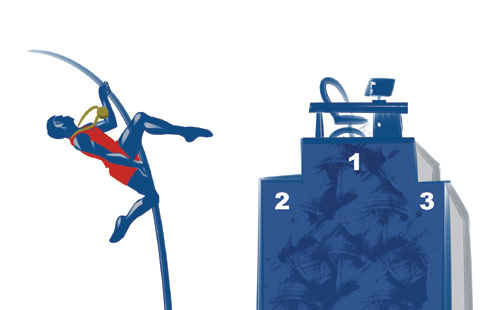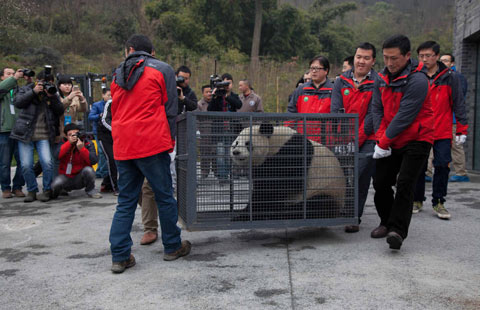Landing scare grounds homemade planes
Updated: 2014-02-27 08:42
By Zhao Lei and Wang Wen (China Daily)
|
|||||||||||
|
 |
| A passenger was in tears as she greeted relatives after disembarking from the MA-60 aircraft. WANG YANG / FOR CHINA DAILY |
'False alarm'
In its statement, issued on Wednesday night, Xi'an Aircraft Industry said it had sent a team of engineers to Shenyang to cooperate with the airline in an investigation. Experts have also been dispatched to check all MA60's in use with foreign carriers.
"The initial findings indicate that a malfunction in the landing gear's signaling system caused a false alarm," said the statement, which added that the company had asked China's civil aviation authorities to ground "some of the aircraft" for safety checks.
He Shengqiang, general manager of Xi'an Aircraft Industry, said the MA-60 series has given satisfactory performance during its period of service with domestic and overseas airlines.
"The feedback from our clients toward the aircraft is fairly good. They are well maintained and serve carriers from 16 countries, including Laos, Cambodia and several African nations," he said. "We are confident in their performance and future."
Despite the series of incidents, some pilots said they still have confidence in the aircraft.
"As long as the aircraft has the correct certification from the authorities, I would be happy to fly it," said one Beijing-based pilot, who declined to be named.
Aviation experts were also quick to play down any doubts about the quality of the MA-60.
The certificate of airworthiness, which the MA-60 has been awarded by China's civil aviation authority, means that the aircraft is safe to fly, according to Wang Qiming, an expert on passenger aircraft and a consultant to the Aviation Industry Corporation of China's committee on science and technology.
"As far as I know, the Xi'an company has a complete system, which covers before-delivery flight testing and in-house supervision by buyers, to guarantee the quality of its aircraft," he said. "So it's too early to make a conclusion on whether the incident is a reflection on the aircraft's quality."
Wang said that investigations into aircraft malfunctions are usually complicated and time-consuming.
Every new-type aircraft will have a relatively higher failure rate during the initial stages of its operations in the market. That even applies to major manufacturers such as Boeing and Airbus, according to Wang.
He said Chinese aircraft manufacturers still have a long way to go, because their experience and ability to deal with setbacks are poor compared with their US and European counterparts.
One industry insider said the incidents involving the MA-60s may act as a catalyst and encourage Chinese civil aircraft builders to attach even greater attention to safety issues.
"These incidents have reminded us once again that safety is the first priority when manufacturing passenger aircraft," said a manager at the Airworthiness Certification Center of the civil aircraft manufacturer Commercial Aircraft Corp of China, also known as COMAC.
Meanwhile, to ensure the full safety of its products, Shanghai-based COMAC has spent more time on its aircraft under development than originally scheduled, said the manager, who spoke on condition of anonymity.
The ARJ21, a regional airplane made by the company, made its maiden flight in 2008, but will not be delivered to buyers until the end of this year.
The aircraft started the airworthiness certification process in September 2012 and only about 50 items have yet to be checked, according to the company.
C919 delays
The maiden test flight of COMAC's C919 - the first Chinese-made large passenger aircraft - has been delayed by a year, until 2015, and the first delivery be not be made 2017, a year later than scheduled. The company has received orders of around 400 from domestic and overseas buyers.
A lack of experience in the manufacture of commercial aircraft is one of the main reasons for the delay, the manager explained.
"Because of our comparatively weak foundation in aviation technology, we have no choice but to take more time," he said. "But at least that will ensure safety."
Wang Ya'nan, deputy editor-in-chief at Aerospace Knowledge magazine, acknowledged the problems faced by China's aircraft manufacturers.
"Every aircraft maker faces the same dilemma after it puts a new product on the market," he said. "Large airlines are reluctant to use new aircraft because they know that doing so will bring potential risks generated by the aircraft, while small carriers, although more likely to use new-type aircraft out of the consideration of cost savings, lack skilled professionals and sufficient operational and maintenance experience, and are thus are more prone to accidents."
"This is exactly the problem the MA-60 is facing," he added. "Chinese manufacturers must figure out a feasible way of selling their planes to large airlines, establish their brands and make profits - but that can only happen if it's based on a good safety record."
The operations of 11 MA-60s owned by Okay Airways and eight owned by Joy Air, a budget airline based in Xi'an, have not been interrupted by Tuesday's incident. However, if the aircraft were grounded, Okay would be affected significantly because half of its 22 passenger jets are MA-60s.
Pang said Xi'an-based company has more than 200 orders for MA-60s.
The MA-60 is a turboprop-powered plane developed and made by Xi'an Aircraft Industry, and is based on the company's own Y-7 transport aircraft. The company has also developed its variant of the MA-60, called the MA-600.
By the end of 2013, 88 MA-60s or MA-600s had been delivered to 24 buyers from 16 nations in Asia, South America and Africa, according to Pang Zhen, head of civil aircraft development at Aviation Industry Corp of China, the parent company of Xi'an Aircraft Industry.
The rising price of aviation fuel has put airlines under heavy financial pressure, making turboprops, which consume less fuel compared with turbofan jets, more attractive to airline procurement managers, according to Pang, who said the global aviation market will need at least 2,900 turboprop regional airliners within the next 20 years, and that China will need around 350 of them.
Xinhua contributed to the story.
Today's Top News
Ukraine disbands riot police unit
Putin puts troops in W.Russia on alert in drill
Construction of China-Russia railway bridge starts
Turks stage protests demand PM's resignation
Forecast:China to lower growth rate
Italian new govt wins vote of confidence
Ukraine enters uncharted water
Li urges stronger S. China Sea ties
Hot Topics
Lunar probe , China growth forecasts, Emission rules get tougher, China seen through 'colored lens', International board,
Editor's Picks

|

|

|

|

|

|





